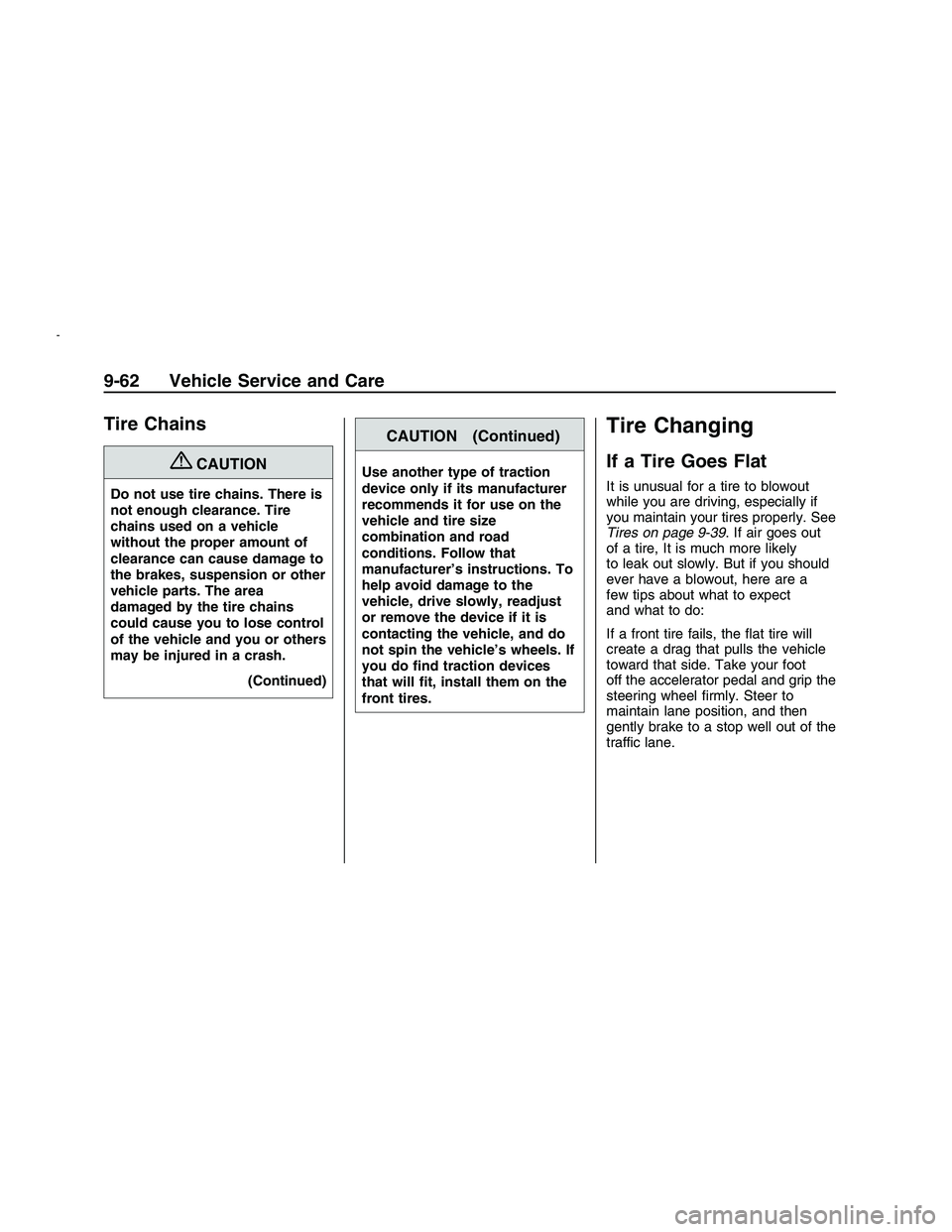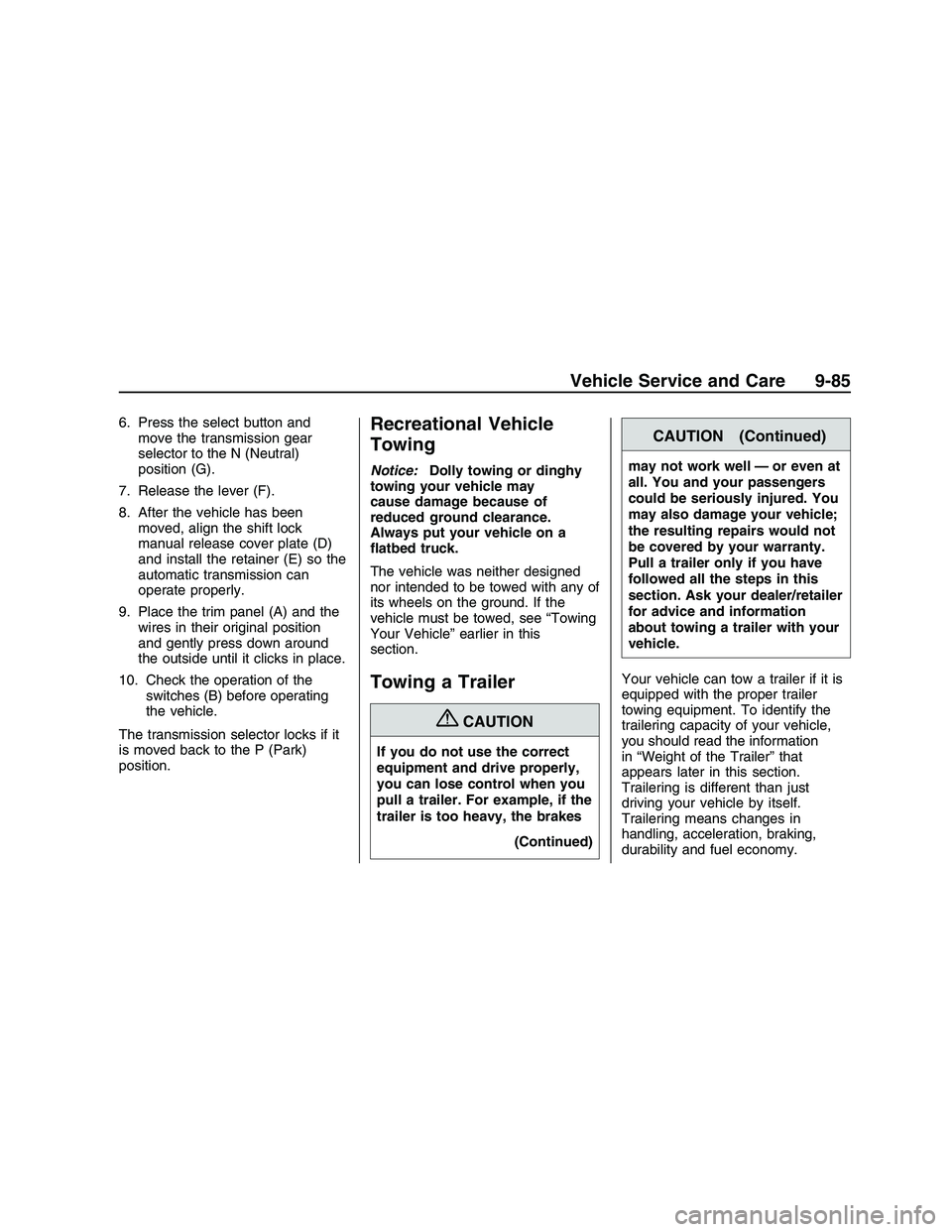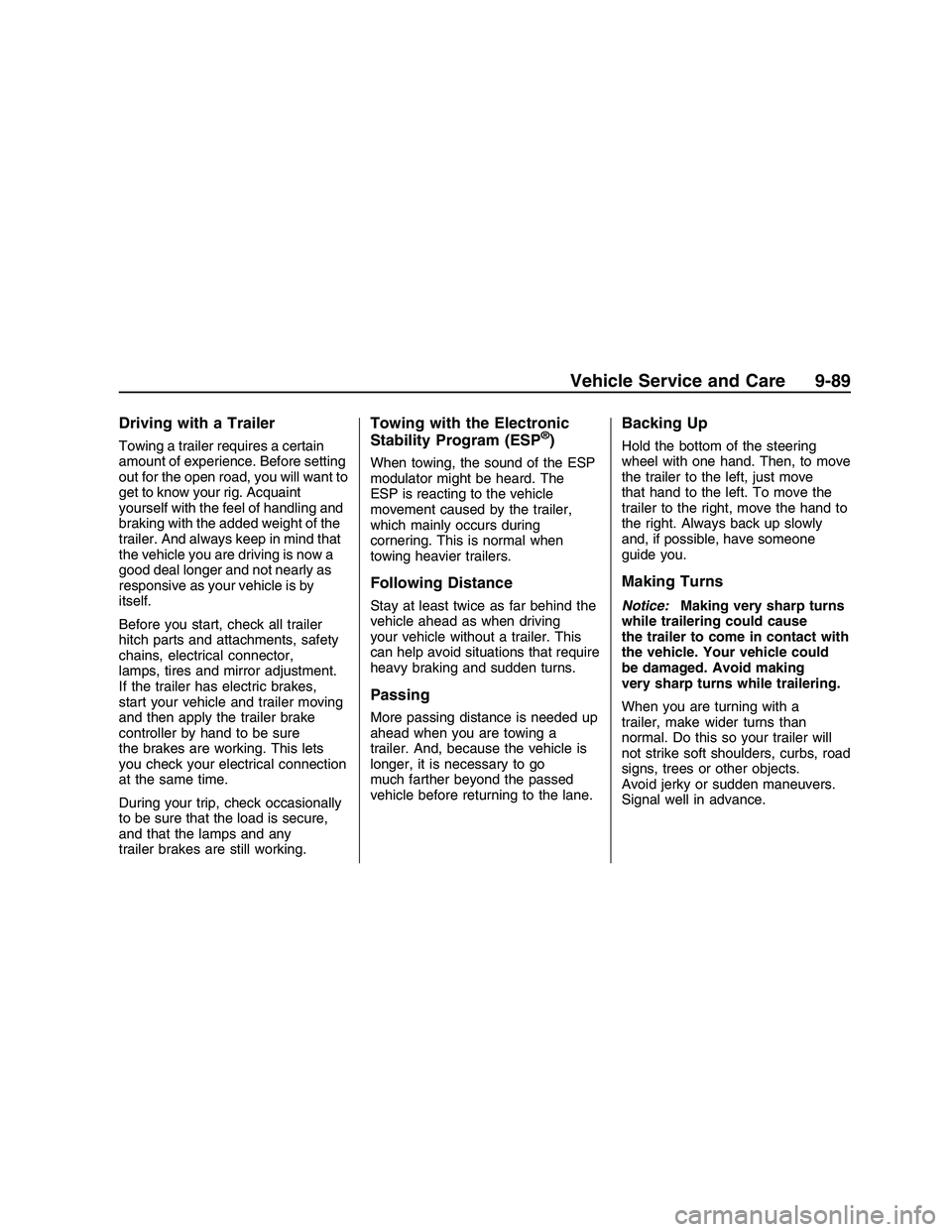2008 PONTIAC G8 brakes
[x] Cancel search: brakesPage 246 of 334

Tire Chains
{CAUTION
Do not use tire chains. There is
not enough clearance. Tire
chains used on a vehicle
without the proper amount of
clearance can cause damage to
the brakes, suspension or other
vehicle parts. The area
damaged by the tire chains
could cause you to lose control
of the vehicle and you or others
may be injured in a crash.
(Continued)
CAUTION (Continued)
Use another type of traction
device only if its manufacturer
recommends it for use on the
vehicle and tire size
combination and road
conditions. Follow that
manufacturer’s instructions. To
help avoid damage to the
vehicle, drive slowly, readjust
or remove the device if it is
contacting the vehicle, and do
not spin the vehicle’s wheels. If
you do �nd traction devices
that will �t, install them on the
front tires.
Tire Changing
If a Tire Goes Flat
It is unusual for a tire to blowout
while you are driving, especially if
you maintain your tires properly. See
Tires on page 9-39. If air goes out
of a tire, It is much more likely
to leak out slowly. But if you should
ever have a blowout, here are a
few tips about what to expect
and what to do:
If a front tire fails, the �at tire will
create a drag that pulls the vehicle
toward that side. Take your foot
off the accelerator pedal and grip the
steering wheel �rmly. Steer to
maintain lane position, and then
gently brake to a stop well out of the
traffic lane.
9-62 Vehicle Service and Care
2008 - Pontiac G8 Owner Manual
Page 269 of 334

6. Press the select button and
move the transmission gear
selector to the N (Neutral)
position (G).
7. Release the lever (F).
8. After the vehicle has been
moved, align the shift lock
manual release cover plate (D)
and install the retainer (E) so the
automatic transmission can
operate properly.
9. Place the trim panel (A) and the
wires in their original position
and gently press down around
the outside until it clicks in place.
10. Check the operation of the
switches (B) before operating
the vehicle.
The transmission selector locks if it
is moved back to the P (Park)
position.Recreational Vehicle
Towing
Notice:Dolly towing or dinghy
towing your vehicle may
cause damage because of
reduced ground clearance.
Always put your vehicle on a
�atbed truck.
The vehicle was neither designed
nor intended to be towed with any of
its wheels on the ground. If the
vehicle must be towed, see “Towing
Your Vehicle” earlier in this
section.
Towing a Trailer
{CAUTION
If you do not use the correct
equipment and drive properly,
you can lose control when you
pull a trailer. For example, if the
trailer is too heavy, the brakes
(Continued)
CAUTION (Continued)
may not work well — or even at
all. You and your passengers
could be seriously injured. You
may also damage your vehicle;
the resulting repairs would not
be covered by your warranty.
Pull a trailer only if you have
followed all the steps in this
section. Ask your dealer/retailer
for advice and information
about towing a trailer with your
vehicle.
Your vehicle can tow a trailer if it is
equipped with the proper trailer
towing equipment. To identify the
trailering capacity of your vehicle,
you should read the information
in “Weight of the Trailer” that
appears later in this section.
Trailering is different than just
driving your vehicle by itself.
Trailering means changes in
handling, acceleration, braking,
durability and fuel economy.
Vehicle Service and Care 9-85
2008 - Pontiac G8 Owner Manual
Page 272 of 334

Total Weight on Your Vehicle’s
Tires
Be sure your vehicle’s tires are
in�ated to the upper limit for cold
tires. You will �nd these numbers on
the Tire-Loading Information label.
SeeLoading the Vehicle on
page 8-28. Then be sure you do not
go over the GVW limit for your
vehicle, including the weight of the
trailer tongue.
Hitches
It is important to have the correct
hitch equipment. Crosswinds,
large trucks going by and rough
roads are a few reasons why
you will need the right hitch. Here
are some rules to follow:
The rear bumper on your vehicle
is not intended for hitches. Do
not attach rental hitches or other
bumper-type hitches to it. Use
only a frame-mounted hitch
that does not attach to the
bumper.
Will you have to make any holes
in the body of your vehicle when
you install a trailer hitch? If you
do, then be sure to seal the holes
later when you remove the hitch.
If you do not seal them, deadly
carbon monoxide (CO) from your
exhaust can get into your vehicle.
SeeEngine Exhaust on
page 8-12. Dirt and water can
also enter the vehicle.
Safety Chains
You should always attach chains
between your vehicle and your
trailer. Cross the safety chains under
the tongue of the trailer so that the
tongue will not drop to the road if it
becomes separated from the hitch.
Instructions about safety chains
may be provided by the hitch
manufacturer or by the trailer
manufacturer. Follow the
manufacturer’s recommendation for
attaching safety chains and do not
attach them to the bumper. Alwaysleave just enough slack so you can
turn with your rig. And, never allow
safety chains to drag on the ground.
Trailer Brakes
Does your trailer have its own
brakes? Be sure to read and follow
the instructions for the trailer
brakes so you will be able to install,
adjust and maintain them properly.
Because you have anti-lock brakes,
do not tap into your vehicle’s brake
system. If you do, both brake
systems will not work well, or at all.
Trailer Wiring Harness
All of the electrical circuits required
for your trailer lighting system
can be accessed at the driver’s side
rear lamp connector. This connector
is located under the carpet on
the rear corner of the trunk
compartment.
9-88 Vehicle Service and Care
2008 - Pontiac G8 Owner Manual
Page 273 of 334

Driving with a Trailer
Towing a trailer requires a certain
amount of experience. Before setting
out for the open road, you will want to
get to know your rig. Acquaint
yourself with the feel of handling and
braking with the added weight of the
trailer. And always keep in mind that
the vehicle you are driving is now a
good deal longer and not nearly as
responsive as your vehicle is by
itself.
Before you start, check all trailer
hitch parts and attachments, safety
chains, electrical connector,
lamps, tires and mirror adjustment.
If the trailer has electric brakes,
start your vehicle and trailer moving
and then apply the trailer brake
controller by hand to be sure
the brakes are working. This lets
you check your electrical connection
at the same time.
During your trip, check occasionally
to be sure that the load is secure,
and that the lamps and any
trailer brakes are still working.
Towing with the Electronic
Stability Program (ESP®)
When towing, the sound of the ESP
modulator might be heard. The
ESP is reacting to the vehicle
movement caused by the trailer,
which mainly occurs during
cornering. This is normal when
towing heavier trailers.
Following Distance
Stay at least twice as far behind the
vehicle ahead as when driving
your vehicle without a trailer. This
can help avoid situations that require
heavy braking and sudden turns.
Passing
More passing distance is needed up
ahead when you are towing a
trailer. And, because the vehicle is
longer, it is necessary to go
much farther beyond the passed
vehicle before returning to the lane.
Backing Up
Hold the bottom of the steering
wheel with one hand. Then, to move
the trailer to the left, just move
that hand to the left. To move the
trailer to the right, move the hand to
the right. Always back up slowly
and, if possible, have someone
guide you.
Making Turns
Notice:Making very sharp turns
while trailering could cause
the trailer to come in contact with
the vehicle. Your vehicle could
be damaged. Avoid making
very sharp turns while trailering.
When you are turning with a
trailer, make wider turns than
normal. Do this so your trailer will
not strike soft shoulders, curbs, road
signs, trees or other objects.
Avoid jerky or sudden maneuvers.
Signal well in advance.
Vehicle Service and Care 9-89
2008 - Pontiac G8 Owner Manual
Page 274 of 334

Turn Signals When Towing a
Trailer
When you tow a trailer, your vehicle
may need a different turn signal
�asher and/or extra wiring. Check
with your dealer/retailer. The arrows
on your instrument panel will
�ash whenever you signal a turn or
lane change. Properly hooked
up, the trailer lamps will also �ash,
telling other drivers you are
about to turn, change lanes or stop.
When towing a trailer, the arrows
on your instrument panel will
�ash for turns even if the bulbs on
the trailer are burned out. Thus, you
may think drivers behind you are
seeing your signal when they
are not. It is important to check
occasionally to be sure the trailer
bulbs are still working.
Your vehicle has bulb warning
lights. When you plug a trailer
lighting system into your vehicle’s
lighting system, its bulb warning
lights may not let you know if one of
your lamps goes out. So, whenyou have a trailer lighting system
plugged in, be sure to check
your vehicle and trailer lamps from
time to time to be sure they are
all working. Once you disconnect the
trailer lamps, the bulb warning
lights again can tell you if one of
your vehicle lamps is out.
Driving On Grades
Reduce speed and shift to a lower
gearbeforeyou start down a
long or steep downgrade. If you do
not shift down, you might have
to use your brakes so much
that they would get hot and no
longer work well.
On a long uphill grade, shift down to
a lower gear and reduce your
speed to around 45 mph (70 km/h)
to reduce the possibility of engine
and transmission overheating.
Parking on Hills
{CAUTION
You really should not park your
vehicle, with a trailer attached,
on a hill. If something goes
wrong, your rig could start to
move. People can be injured,
and both your vehicle and the
trailer can be damaged.
But if you ever have to park your rig
on a hill, here is how to do it:
1. Apply your regular brakes, but do
not shift into P (Park) yet.
2. Have someone place chocks
under the trailer wheels.
3. When the wheel chocks are in
place, release the regular
brakes until the chocks absorb
the load.
4. Reapply the regular brakes.
Then apply your parking
brake, and then shift to P (Park).
5. Release the regular brakes.
9-90 Vehicle Service and Care
2008 - Pontiac G8 Owner Manual
Page 275 of 334

When You Are Ready to Leave
After Parking on a Hill
1. Apply your regular brakes and
hold the pedal down while you:
Start your engine.
Shift into a gear.
Release the parking brake.
2. Let up on the brake pedal.
3. Drive slowly until the trailer is
clear of the chocks.
4. Stop and have someone pick up
and store the chocks.
Maintenance When Trailer
Towing
Your vehicle will need service more
often when you’re pulling a trailer.
See the Maintenance Schedule for
more on this. Things that are
especially important in trailer
operation are automatic transmission
�uid (don’t over�ll), engine oil, drivebelt, cooling system and brake
system. Each of these is covered in
this manual, and the Index will help
you �nd them quickly. If you’re
trailering, it’s a good idea to review
this information before you start
your trip.
Check periodically to see that all
hitch nuts and bolts are tight.
Engine Cooling When Trailer
Towing
Your cooling system may
temporarily overheat during severe
operating conditions. SeeEngine
Overheating on page 9-16.
Appearance Care
Interior Cleaning
Your vehicle’s interior will continue
to look its best if it is cleaned
often. Although not always visible,
dust and dirt can accumulate
on your upholstery. Dirt can damage
carpet, fabric, leather, and plastic
surfaces. Regular vacuuming
is recommended to remove particles
from the upholstery. It is important
to keep your upholstery from
becoming and remaining heavily
soiled. Soils should be removed as
quickly as possible. Your vehicle’s
interior may experience extremes of
heat that could cause stains to
set rapidly.
Lighter colored interiors may require
more frequent cleaning. Use care
because newspapers and garments
that transfer color to your home
furnishings may also transfer color
to your vehicle’s interior.
Vehicle Service and Care 9-91
2008 - Pontiac G8 Owner Manual
Page 296 of 334

(e)Make sure the safety belt
reminder light and safety belt
assemblies are working properly.
Look for any other loose or
damaged safety belt system parts. If
you see anything that might keep
a safety belt system from doing
its job, have it repaired. Have any
torn or frayed safety belts replaced.
Also see Airbag System Check
on page 1-31.
(f)Lubricate all key lock cylinders,
door hinges and latches, hood
hinges and latches and trunk lid
hinges and latches. More frequent
lubrication may be required
when exposed to a corrosive
environment. Applying silicone
grease on weatherstrips with a clean
cloth will make them last longer,
seal better, and not stick or squeak.
(g)Visually inspect belt for fraying,
excessive cracks, or obvious
damage. Replace belt if necessary.(h)Change automatic transmission
fluid and filter if the vehicle is
mainly driven under one or more of
these conditions:
�In heavy city traffic where the
outside temperature regularly
reaches 90°F (32°C) or higher.
�In hilly or mountainous terrain.
�When doing frequent trailer
towing.
�Uses such as found in taxi,
police, or delivery service.
(i)Drain, flush, and refill cooling
system. This service can be
complex; you should have your
dealer/retailer perform this service.
See Engine Coolant on page 9-13 for
what to use. Inspect hoses. Clean
radiator, condenser, pressure cap,
and filler neck. Pressure test the
cooling system and pressure cap.(j)A fluid loss in any vehicle system
could indicate a problem. Have
the system inspected and repaired
and the fluid level checked. Add
fluid if needed.
(k)If you drive regularly under dusty
conditions, inspect the filter at
each engine oil change.
(l)If you drive regularly under dusty
conditions, the filter may require
replacement more often.
(m)Drain, flush, and refill brake
hydraulic system at a regular service
interval (IorII) every two years.
This service can be complex;
you should have your dealer/retailer
perform this service. See Brakes
on page 9-24.
11-8 Service and Maintenance
2008 - Pontiac G8 Owner Manual
Page 321 of 334

In Canada, call 1-800-263-3777
(English) or 1-800-263-7854
(French), or write:
General Motors of Canada Limited
Customer Communication Centre,
CA1-163-005
1908 Colonel Sam Drive
Oshawa, Ontario L1H 8P7
Service Publications
Ordering Information
Service Manuals
Service Manuals have the diagnosis
and repair information on engines,
transmission, axle suspension,
brakes, electrical, steering, body, etc.
Service Bulletins
Service Bulletins give additional
technical service information
needed to knowledgeably service
General Motors cars and trucks.
Each bulletin contains instructions to
assist in the diagnosis and service
of your vehicle.
Owner Information
Owner publications are written
speci�cally for owners and intended
to provide basic operational
information about the vehicle.
The owner manual includes the
Maintenance Schedule for all
models.
In-Portfolio: Includes a Portfolio,
Owner Manual, and Warranty
Booklet.
RETAIL SELL PRICE:
$35.00 (U.S.) plus processing fee
Without Portfolio:
Owner Manual only.
RETAIL SELL PRICE:
$25.00 (U.S.) plus processing fee
Current and Past Model
Order Forms
Technical Service Bulletins and
Manuals are available for current
and past model GM vehicles.
To request an order form, specify
year and model name of the vehicle.ORDER TOLL FREE:
1-800-551-4123 Monday-Friday
8:00 AM - 6:00 PM Eastern Time
For Credit Card Orders Only
(VISA-MasterCard-Discover), visit
Helm, Inc. on the World Wide
Web at: helminc.com
Or you can write to:
Helm, Incorporated
P.O. Box 07130
Detroit, MI 48207
Prices are subject to change
without notice and without incurring
obligation. Allow ample time for
delivery.
Note to Canadian Customers:
All listed prices are quoted in
U.S. funds. Canadian residents
are to make checks payable
in U.S. funds.
Customer Information 12-15
2008 - Pontiac G8 Owner Manual